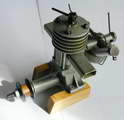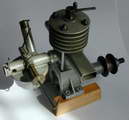| Name | ETA "5" Types "CI" and "S" |
Designer | Eric Bedford |
| Bore | 17.06 mm (0.672") |
Stroke | 21.83 mm (0.859") |
| Type | Compression Ignition | Capacity | 4.99cc (.305 cuin) |
| Production run | 1500 (est) | Country of Origin | England |
| Photos by | Ron C, Bert Streigler, and Ken Croft | Year of manufacture | 1947..1950 |
Background
The ETA "5" has a delightfully vintage look to it; the long cylinder studs, the cast, tapered fins, the mysterious garden of levers growing out of the carby. The first advertisement for the engine appeared in the July 1947 issue of Aeromodeller. It continued to appear in ETA ads, even after the introduction of the more modern-looking, high-performance ETA 19 and ETA 29 "GP" models (which may stand for Glow Plug). Manufacturer, ETA Instruments Ltd of Herts, England, phased out the "5" during 1949/50, with the last advertised appearance of the engine by ETA was in the Aeromodeller of March, 1950.
It's well known that the ETA racing engines were designed by Ken Bedford, but the "5" is so different from them in so many ways that I asked Ron Moulton, a past editor of Aeromodeller, and personal friend of Ken to find out what he could for us. The story is most enlightening and as far as I know, has not been recorded before. Here is what Ron found out from Ken [1]:
"[Ken Bedford's] father, C.J.Bedford, migrated from New Zealand with two very young sons and established a Motor Car agency and repair and maintenance garage in Watford. After over 75 years, it still exists but has changed hands many times. C.J. then went into light engineering. Elder son Eric did all the design work on the ETA 5. Everything was made in-house. Father and younger son Ken produced tooling so it was an all-NZ effort, in England during the late 40s. They recognised the need for higher performance engines, which were then designed by Ken who incidentally also did the pressure diecasting himself and introduced lost wax casting of cylinders in the "15" size diesels."
And the rest, as they say, is history. Production of the Ken Bedford designed ETA engines continued until 1974. Today, they too are highly sought after and prized collectables.
Models
 ETA produced two different models of the "5" which they designated the "CI" and the "R". This ETA advertisement from the October 1948 issue of Aeromodeller lists a "Type 5CI" for £7/19/6, with the "Type R" £1 cheaper. I was unable to find official details of the differences between the two models, but we can make some educated guesses. First, according to Mike Clanford's A-Z reference, the "R" variant of the "5" had a red spinner and head, plus a simplified carburettor for use in model cars [2]. Sadly, there are enough mistakes in in Clanford's A-Z to call into question statements with no corroborating evidence, so we need to look further.
ETA produced two different models of the "5" which they designated the "CI" and the "R". This ETA advertisement from the October 1948 issue of Aeromodeller lists a "Type 5CI" for £7/19/6, with the "Type R" £1 cheaper. I was unable to find official details of the differences between the two models, but we can make some educated guesses. First, according to Mike Clanford's A-Z reference, the "R" variant of the "5" had a red spinner and head, plus a simplified carburettor for use in model cars [2]. Sadly, there are enough mistakes in in Clanford's A-Z to call into question statements with no corroborating evidence, so we need to look further.
 ETA's advertisement from February 1949 clearly shows the "R" model as being a full ounce lighter than the "C-I" (note the subtle change in the type designation). The replacement of the complex tank/venturi assembly with a simple turned inlet would account for this weight saving, supporting Clanford's designation of the venturi equipped model as an "R". Add to this a sentence in Gordon Counsell's review of the engine from Issue #1 of Model Engine World, May 1994:
ETA's advertisement from February 1949 clearly shows the "R" model as being a full ounce lighter than the "C-I" (note the subtle change in the type designation). The replacement of the complex tank/venturi assembly with a simple turned inlet would account for this weight saving, supporting Clanford's designation of the venturi equipped model as an "R". Add to this a sentence in Gordon Counsell's review of the engine from Issue #1 of Model Engine World, May 1994:
[the] engine test by Lawerence Sparey in the September 1948 [Aeromodeller] issue gave a figure of £7.19.6d for the SCI (sic) model tested, a version for control line or tether car work with a short venturi, no tank, and red head being offered at £1-0-0 less.
[3]This too supports Clanford, but as the article gives no references, the information could well have come from Clanford's 1987 book for all we know. Notice also the reference to a non-existent "SCI" model, where the "5" has mutated into an "S". And as we'll soon see, Lawerence Sparey's review makes no mention of an "R" model as the quote would suggest. But we can't be too harsh, as ETA's designations in their advertisements were somewhat amorphous themselves.
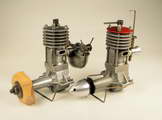 These photos shows the two examples in Bert Streigler's collection. Bert says the spinner of the engine on the right had been polished by the time it came to him, so we don't know if it was ever red. But there's no doubt about the red head, and notice that the needle is identical to that fitted to the CI model. The patina on the needle and spray bar argues that they are original. Apart from the polished spinner, this engine is the same as that listed as an "R" model in Clanford. An engine like this would make perfect sense for a control-line model, and could be used in a tether-car, probably without the spinner nut. Notice the shiny castings on Bert's "CI" model as opposed to the matt finish on the "S" and on the engine at the head of this page? We'll come back to that after looking at what LHS had to say.
These photos shows the two examples in Bert Streigler's collection. Bert says the spinner of the engine on the right had been polished by the time it came to him, so we don't know if it was ever red. But there's no doubt about the red head, and notice that the needle is identical to that fitted to the CI model. The patina on the needle and spray bar argues that they are original. Apart from the polished spinner, this engine is the same as that listed as an "R" model in Clanford. An engine like this would make perfect sense for a control-line model, and could be used in a tether-car, probably without the spinner nut. Notice the shiny castings on Bert's "CI" model as opposed to the matt finish on the "S" and on the engine at the head of this page? We'll come back to that after looking at what LHS had to say.
 |
 |
The ETA "5" was the subject of Aeromodeller's Engine Analysis Number Five, conducted by Lawerence H Sparey in the September 1948 issue. Sparey found the engine to be well made, but "inflexible" in operation. He also noted that each engine was independently tested by two inspectors and was accompanied by twelve pages of literature [4]. The test report listed the prices of accessories available for the engine. The exhaust extension tubes and extended filler tubes mentioned as optional accessories at the end of the review are visible on the example in the photographs at the head of this page. The report makes no mention of the "R" model, and the price quoted matches that for the "CI" in the ETA advertising. However, in the list of accessories we see:
To add to the confusion, this public notice by ETA appeared in the June 1948 issue of the Aeromodeller. It indicates that some changes were being made to the porting and announced the "short venturi" mentioned by Sparey. It also announced four new ETA engines that, as far as we are aware, never saw the light of day (although the "ETA 30 GP ignitionless" may have become the 29 "GP").
 Two months later, in the August 1948 issue of Aeromodeller, one month before Sparey's review would appear, ETA quietly announced the "R" model at £1 less than the "C.I." engine. Given magazine lead times, Sparey's review was almost certainly complete by this time. But the "E/45 Venturi conversion unit" carries the same price of 14/8 (fourteen shillings and eight pence) that Sparey listed to the penny, even if he did not mention the "R" type. But we can now date the "R" with the August 1948 issue, and observe that no mention is made of it being specifically for tether cars as Clanford states.
Two months later, in the August 1948 issue of Aeromodeller, one month before Sparey's review would appear, ETA quietly announced the "R" model at £1 less than the "C.I." engine. Given magazine lead times, Sparey's review was almost certainly complete by this time. But the "E/45 Venturi conversion unit" carries the same price of 14/8 (fourteen shillings and eight pence) that Sparey listed to the penny, even if he did not mention the "R" type. But we can now date the "R" with the August 1948 issue, and observe that no mention is made of it being specifically for tether cars as Clanford states.
Finish and Serial Numbers
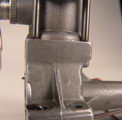 There is some confusion over the finish of the engines. Some examples have a natural, shiny, aluminium finish. Others exhibit a matt grey on all the cast components. The Model Engine World reviewers both believed this to be "anodic" [3][5]. I'm more inclined to say it is the result of sandblasting, or less likely, heat treating after casting (Sparey says the material used was hiduminium, a British aircraft-grade alloy). This photo shows the grey finish on Bert Streigler's Type "R" example. Close examination of Bert's outstanding photography shows several light scratches and a place on the front of the mounting lugs where the matt finish has been worn off; probably, as Bert says, from bouncing around inside a box. Anodizing produces a very hard, non-conducting, aluminium oxide layer (aluminium oxide granules are commonly used as an abrasive). An ohm-meter test on #44879 showed the surface to be fully conducting, strongly suggesting that no cases were anodized.
There is some confusion over the finish of the engines. Some examples have a natural, shiny, aluminium finish. Others exhibit a matt grey on all the cast components. The Model Engine World reviewers both believed this to be "anodic" [3][5]. I'm more inclined to say it is the result of sandblasting, or less likely, heat treating after casting (Sparey says the material used was hiduminium, a British aircraft-grade alloy). This photo shows the grey finish on Bert Streigler's Type "R" example. Close examination of Bert's outstanding photography shows several light scratches and a place on the front of the mounting lugs where the matt finish has been worn off; probably, as Bert says, from bouncing around inside a box. Anodizing produces a very hard, non-conducting, aluminium oxide layer (aluminium oxide granules are commonly used as an abrasive). An ohm-meter test on #44879 showed the surface to be fully conducting, strongly suggesting that no cases were anodized.
As mentioned in the ETA 29 page, the company used a complex and inconsistent serial number sequence. Based on the five examples we've been able to examine, the serial number for the "5" probably was composed this way:
<month><two-digit-year><sequence-number-in-month>The table below shows the serial number and finish on the engines the Motor Boys have been able to examine.
| Serial # | Type | Finish | Date |
| 74756 | CI | Shiny | July 1947 |
| 34810 | CI | Matt | March 1948 |
| 44823 | CI | Matt | April 1948 |
| 44879 | R | Matt | April 1948 |
| 94881 | CI | Matt | Sept 1948 |
A close reading of the heading in the October 1948 advertisement above announces the 1948 ETA "5" Silver Series. From the evidence to hand, this would appear to have absolutely nothing to do with the case finish, as the only "silver" engine we have would appear to be from well before this date. But then, we don't have any examples from after the announcement date either, so this is all highly open to error.
The End
 To close off our totally circumstantial history, notice the little text inserts next to the "5" in this advertisement from one year later in October 1949. The first says: "In full production again". This suggests that there was a hiatus in "5" production during 1949. The type has undergone Yet Another mutation to "C.I." this time. Feels like creative ways to use the same letters, but never precisely the same way twice. Finally, notice that while the 29 "GP" was available from your friendly reputable retailer, the "5" was "Direct from ETA only", and was being offered at a massive price reduction of £3/7/- in comparison to the earlier advertised price for the CI model. That's 42% less for those rusty on their pounds, shillings and pence. With no evidence, I'd surmise that ETA had decided that the day of the big 5cc side-port diesel was done and were probably clearing out their inventory of engines in which dealers were no longer interested, and perhaps converting their spares into engines as well.
To close off our totally circumstantial history, notice the little text inserts next to the "5" in this advertisement from one year later in October 1949. The first says: "In full production again". This suggests that there was a hiatus in "5" production during 1949. The type has undergone Yet Another mutation to "C.I." this time. Feels like creative ways to use the same letters, but never precisely the same way twice. Finally, notice that while the 29 "GP" was available from your friendly reputable retailer, the "5" was "Direct from ETA only", and was being offered at a massive price reduction of £3/7/- in comparison to the earlier advertised price for the CI model. That's 42% less for those rusty on their pounds, shillings and pence. With no evidence, I'd surmise that ETA had decided that the day of the big 5cc side-port diesel was done and were probably clearing out their inventory of engines in which dealers were no longer interested, and perhaps converting their spares into engines as well.
Technical Description
The ETA "5" is a "long-stroke", side-port, plain-bearing, compression ignition engine. The crankcase, cylinder head, and tank top are aluminium die castings with either a shiny, or fine, matt grey finish. The steel cylinder liner is a shrink-fit in the cooling jacket, protruding at the bottom to form a spigot that fits the crankcase. The cast fins taper towards their edges and have rounded tips and gap roots for optimum thermal dissipation in the finest ETW tradition. A forward facing bulge provides the transfer passage and carries the designation "5" in raised lettering, together with the company trade mark: the Greek letter "η" (eta, a symbol often used to denote efficiency).The engine features a number of unusual and innovative features. The cast-iron piston is shrunk onto an alloy gudgeon pin carrier. The result is a piston unmarred by holes and no possibility of the pin rubbing on the cylinder walls, jamming in the transfer or inlet ports, or ever being removed! Long studs screw into the crankcase. Domed hex nuts pull the head and cylinder down onto the crankcase seat. One of these nuts is extended so that it prevents more then one turn of compression adjustment. The tommy-bar screws into one of two tapped holes at 90° to each other in the compression screw to allow a running location to be established and set at the factory. The intent was to prevent owners from over-compressing the engine, or "loosing" the setting by backing off too far. This scheme was common on early diesels--probably influenced by its appearance on the Dyno. This works fine provided the fuel mix used in the field is the same as that used at the factory! It also frustrates clearing a flood by backing off the compression significantly. Note that there is no "correct" stud for the compression-stop nut. It will have been factory selected for each engine by one of those two inspectors.
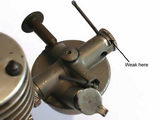 The assortment of levers on the tank top are what endears the ETA "5" to many collectors, yours-truly included. The engine inducts air through two holes in the sides of the rear facing venturi. A plug in the end with mating holes provides a rotatable, spring-loaded choke, actuated by the lateral operating lever to provide a degree of speed adjustment. The fore-aft acting, spring-loaded lever in the middle operates a cut-off that closes off the fuel supply and is biased to the "run" position.
The assortment of levers on the tank top are what endears the ETA "5" to many collectors, yours-truly included. The engine inducts air through two holes in the sides of the rear facing venturi. A plug in the end with mating holes provides a rotatable, spring-loaded choke, actuated by the lateral operating lever to provide a degree of speed adjustment. The fore-aft acting, spring-loaded lever in the middle operates a cut-off that closes off the fuel supply and is biased to the "run" position.
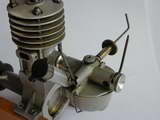 This is exactly reverse to the cut-offs on the Mills engines which were biased to "off", and operated by admitting more air to kill the fuel flow. The fuel tank is a complex aluminium stamping retained by an under-slung spring clip. A central depression provides a sump-like fuel pick-up area to the rear. Sparey calls this the ETA "last drop" container. A filler with a spring cap completed the inventory of things sprouting from the assembly which threads into the cylinder and is locked by a knurled ring allowing it to be rotated for inverted running.
This is exactly reverse to the cut-offs on the Mills engines which were biased to "off", and operated by admitting more air to kill the fuel flow. The fuel tank is a complex aluminium stamping retained by an under-slung spring clip. A central depression provides a sump-like fuel pick-up area to the rear. Sparey calls this the ETA "last drop" container. A filler with a spring cap completed the inventory of things sprouting from the assembly which threads into the cylinder and is locked by a knurled ring allowing it to be rotated for inverted running.
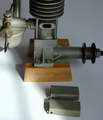 The crankcase has lugs set for center line mounting, reinforced by webs in a rather ETW-ish way. Then again, it could be in a motorcycle-ish way. The short exhaust stubs were drilled and tapped fore and aft to allow the optional aluminium exhaust extension tubes to be fitted. The turned, screw-in backplate has a complex, rebated flange with four semi-circular holes for a pin-spanner. A similar design was later adopted on the early Elfin engines. The prop driver is steel, fitted to the shaft on a simple shoulder and held only by the pressure of the prop nut pushing the driver against the step. This was an ETA safety measure intended to allow the driver to turn on the shaft in the event of a "sudden arrival".
The crankcase has lugs set for center line mounting, reinforced by webs in a rather ETW-ish way. Then again, it could be in a motorcycle-ish way. The short exhaust stubs were drilled and tapped fore and aft to allow the optional aluminium exhaust extension tubes to be fitted. The turned, screw-in backplate has a complex, rebated flange with four semi-circular holes for a pin-spanner. A similar design was later adopted on the early Elfin engines. The prop driver is steel, fitted to the shaft on a simple shoulder and held only by the pressure of the prop nut pushing the driver against the step. This was an ETA safety measure intended to allow the driver to turn on the shaft in the event of a "sudden arrival".
Eagle-eyed readers will have noticed the spinner nut in the ETA advertisement photo, the Aeromodeller cut-away drawing, and one of Bert Streigler's engines, while the other examples and the Aeromodeller 3-view show a plain hex prop-nut. As far as I've been able to determine, both are correct, as engines were supplied with both! The spinner nut was counterbored to cover the nut, providing some additional safeguard against things coming undone. This scheme has also appeared on Taipan engines.
Performance
What can we say? Adequate, but not outstanding. Sparey called the engine "inflexible", as did Gordon Counsell who reported that attempts to reduce the rpm by backing off the compression always resulted in a dead stop, as did moving the choke lever--which was intended for precisely that purpose! This "one-speed only" characteristic has been confirmed by Motor Boy, Ken Croft from running the example in his collection. The distinctly different style between the "5" and the later ETA models led Counsell to surmise--correctly as we now know--that it was not designed by Ken Bedford [3].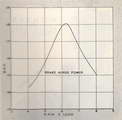 Counsell also conjectured that the unusually sharp torque curve shown in Sparey's review of the engine--and other reviews he conducted--was a result of improper testing technique. Consell suggests that Sparey varied the engine speed by adjusting the engine settings rather than by changing the load and operating at optimum setting for that load. Given the curve taken from the Aeromodeller review as seen here, this is not an unreasonable conclusion, although I'd doubt that Sparey would be unaware that this action would invalidate his performance figures. But narrow port timing could also account for this and would explain why the engine will only operate over a narrow rpm band. A 1998 review using a limited range of calibrated props also suggests a fast torque roll-off in the 7,000 rpm region [5] (note that this review incorrectly gives the year of introduction as 1948).
Counsell also conjectured that the unusually sharp torque curve shown in Sparey's review of the engine--and other reviews he conducted--was a result of improper testing technique. Consell suggests that Sparey varied the engine speed by adjusting the engine settings rather than by changing the load and operating at optimum setting for that load. Given the curve taken from the Aeromodeller review as seen here, this is not an unreasonable conclusion, although I'd doubt that Sparey would be unaware that this action would invalidate his performance figures. But narrow port timing could also account for this and would explain why the engine will only operate over a narrow rpm band. A 1998 review using a limited range of calibrated props also suggests a fast torque roll-off in the 7,000 rpm region [5] (note that this review incorrectly gives the year of introduction as 1948).
Conclusion
There seems little doubt that the ETA "5" lacks the wide speed range normally associated with long-stroke compression ignition engines. Nevertheless, OFW Fisher names this engine "...the first quality English 5cc diesel..." [6]. Today, the unmistakable ETA "5" is an icon of the large, early British diesels. And, like the D-C Wildcat, had a relatively short production life making it rare, and highly attractive to modern collectors. But above all else, it has character. The engine pictured at the top of the page is in Ray Strinati's collection. Ray says his family is under instruction: this one goes with him, inside the coffin!
References:
| [1] | Moulton, R: private correspondence with the author, 2006-06-29. |
| [2] | Clanford, M: A Pictorial A To Z of Vintage and Classic Model Airplane Engines, Clan Enterprises, Surrey 1987, p67. |
| [3] | Counsell, G: Test Review: The ETA 5 Diesel, Model Engine World, Volume 1, Number 1, May 1994, p7. |
| [4] | Sparey, LH: Engine Analysis Number 5: The ETA "5", Model Engine Tests of Yesteryear, compiled by Geoff Clarke, Double M publishing, London, 1981, p 100. |
| [5] | Roberts, RW: Engine Test and Review: The ETA 5 Diesel, Model Engine World, Volume 5, Number 7, November 1998, p12. |
| [6] | Fisher OFW: Collector's Guide to Model Aero Engines, Model and Allied Publications, Argus Books, Watford England, 1977, p 41. |
![]()
